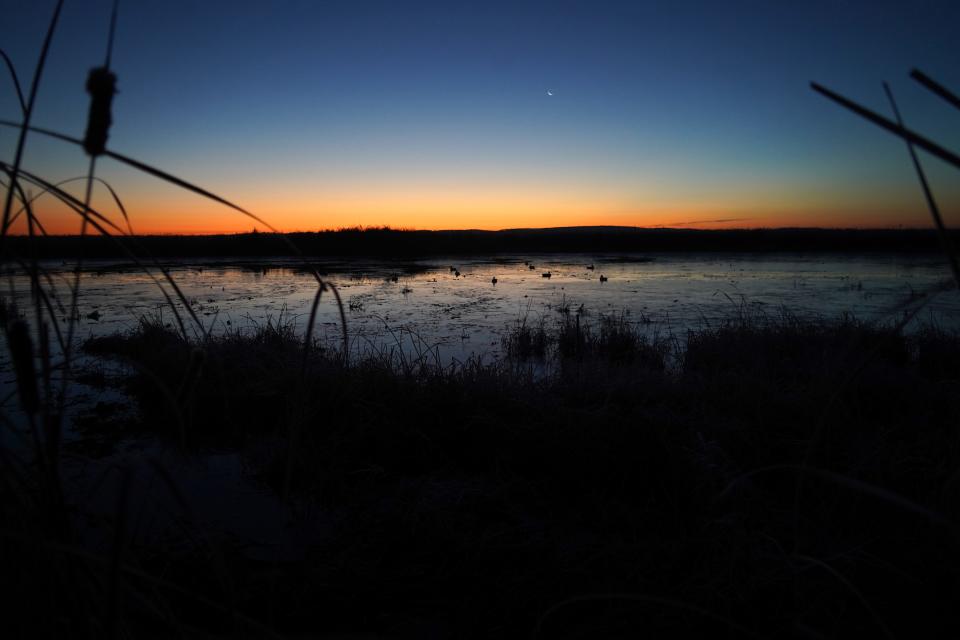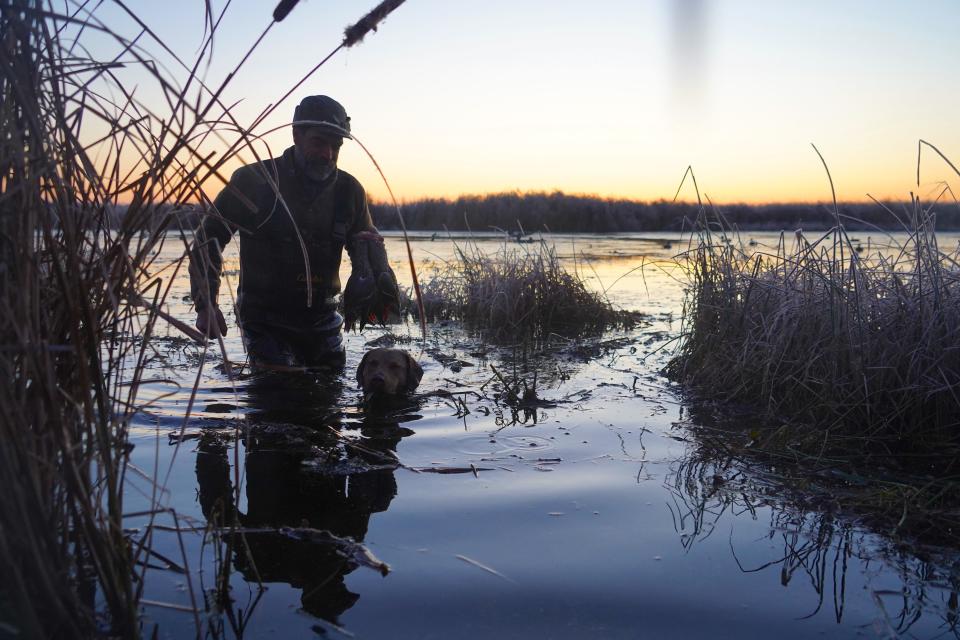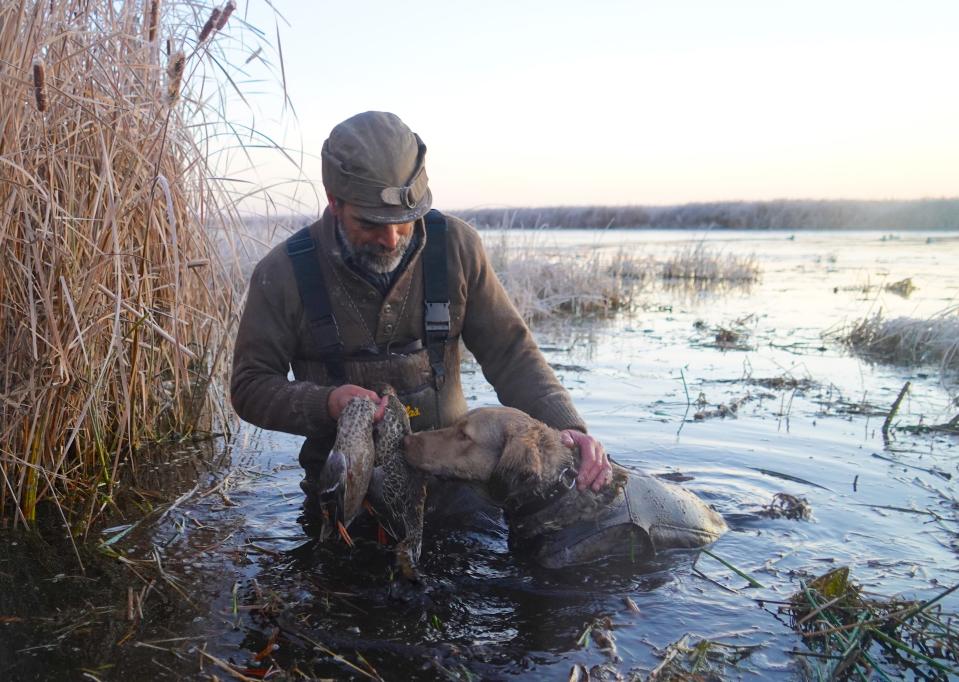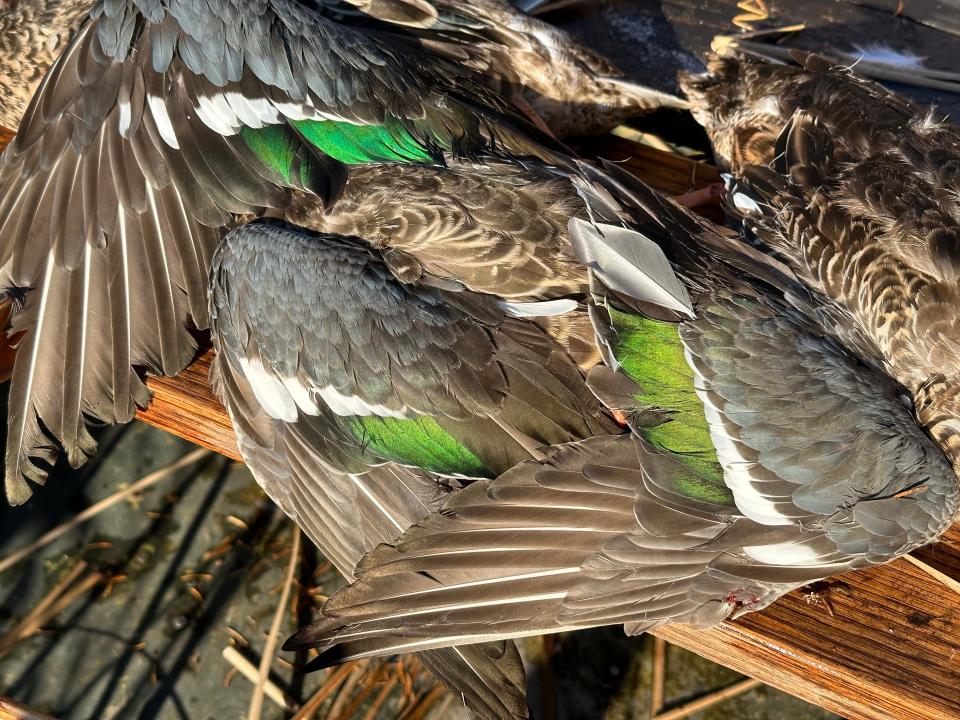Smith: Horicon Marsh yields riches to Armistice Day duck hunters
HORICON - In the distance a crescent moon climbed into the purple sky as orange light flooded over the horizon.
Closer to our east two dozen decoys floated placidly in a 60-yard-wide channel of water and broken ice among the cattail expanse of Horicon Marsh State Wildlife Area.
And immediately overhead mallards and northern shovelers flew repeated sorties through the still, early morning air.
The time was 5:57 a.m., 17 minutes before legal shooting time, and the birds were showing up in force.
Their wings sounded like ripping cloth as they spun down to inspect our imitations. Several shovelers were convinced to stay; they paddled in the water or stood on the ice.
The conditions in our blind were anything but calm.
"They're right on top of us," whispered my hunting partner Bryan Muche of Barrington Hills, Illinois. "This is going to be a long 17 minutes."
The challenge wasn't so much for Muche and me to muster the restraint to hold our shots. We abide by the regulations and ethics.
It was to keep Pep, Muche's 11-month-old Chesapeake Bay retriever, in the blind.
The sights, sounds and smells of so many live ducks so close had Pep straining to jump out and try to bring one to us.
Muche and I smiled at Pep's raw enthusiasm. It was her first duck hunt and, all things considered, she was being a very good girl.

We had gathered Nov. 11 for our annual Armistice Day waterfowl hunt.
For the last 13 years, Muche and I have ventured out to give thanks for the freedoms won by previous generations of Americans as well as pay homage to our waterfowl hunting heritage and Gordon MacQuarrie, the late, great Milwaukee Journal outdoors writer.
November 11 has primary historical significance as the end of the Great War, or World War I. The armistice was declared in Europe at the 11th hour on the 11th day of the 11th month of 1918.
Both of my grandfathers, John Simopulos of Racine and Julius Ziehm of Berlin, served in the U.S. Army in Europe during the war. Within weeks of the Armistice, both were on ships heading back to the States to continue with their lives.
If they hadn't survived my parents wouldn't have been born and someone else would be writing stories for today's Outdoors Page. So, as I'm sure is true with many of you, though it took place long ago and far away the Great War also was significant in my family history.
But Armistice Day is also well-known in the fields of meteorology and waterfowl hunting for the Nov. 11, 1940, storm that crashed down on the Upper Midwest.
The weather system first brought great flocks of migrating birds and "circus shooting" for hunters and then turned deadly as the wind howled, precipitation fell and temperatures plummeted.
MacQuarrie did not hunt that day. But in the wake of the storm he traveled to western Wisconsin to interview survivors and first-responders. His account became famous in the conservation community.
"The winds of Hell were loose on the Mississippi Armistice Day and night," MacQuarrie wrote in the Milwaukee Journal. "They charged down from the river bluffs to the placid stream below and reached with deathly fingers for the life that beat beneath the canvas jackets of thousands of duck hunters."
One-hundred-fifty-four lives were lost in the storm, including 13 in Wisconsin, according to a Milwaukee Journal report.

Waterfowl hunters, including two on Big Muskego Lake in Waukesha County and many on the Mississippi River, were among the dead. The death toll also included sailors and passengers on several ships sunk on Lake Michigan.
This year marked the 83th anniversary of the storm.
The odds are essentially zero of a similar mega storm surprising contemporary hunters. With cell phones and Dopplar radar at our fingertips, we can call for help and monitor weather unlike any generation before.
And although we might opt to dress in canvas as a hat tip to tradition, we also have modern waterproof gear along just in case.
Muche, who was raised in southern Wisconsin and now lives a few miles over the border in Illinois, learned to love Horicon Marsh by joining his family on hunting outings in the area.
His grandfather, Walter Muche Sr., lived and worked in Mayville and started the family tradition of hunting on the famous wetland.
At one point, Walter Muche Sr. worked as a hunting guide and manager at Goose Haven Gun Club in Mayville.
The club was a hot spot during the marsh's goose hunting hay-days in the 1950s and 60s.
Bryan Muche now carries on the family tradition by returning to the marsh multiple times each fall.
Our Armistice Day outings have mostly taken place on the wetland but on three occasions it has been frozen and required us to hunt in fields or an open stretch of the Rock River.

This year brought 20 degree overnight temperatures that, combined with no wind, formed a crust of ice on Horicon's shallow channels.
Plates of 1/4-inch-thick ice shattered as Muche motored our skiff into position about 4:30 a.m.
At 5:30 the mercury read 26 and a 2 mph south wind barely tickled the marsh grass. Catttail heads wore a thick coat of frost and our breath formed clouds of steam as we talked in the blind.
By 5:45 the sounds of wings became more frequent and minutes later the birds started to stream into our spread.
At 6:15, a pair of shovelers came in, landing gear down, and we took our first shots. And finally Muche released Pep.
The tawny dog splashed out to the first retrieves of her duck hunting life. Pep got well-deserved head rubs when she made it back to the blind.
The next half hour featured pairs and triples and flocks working our remote channel. Most were shovelers but a few groups of mallards were mixed in, too.
Our bag began to fill. After each retrieve we'd sit quiet and within 5 minutes more ducks would work the channel. Not all presented shots but it was an incredible show at the heavily-pressured public marsh.
"This is as good of action as we've ever had on Armistice Day," Muche said.

It all took place with only one other hunting group in the area.
By 7:15 the flights slowed and we relaxed in the blind. Muche had a limit of six ducks and I had two. Interestingly, all were shovelers.
As the sun rose the air warmed and it grew mild, perhaps similar to what the hunters in 1940 experienced before the storm struck.
But Armistice Day 2023 ended very differently. Muche and I motored back to the landing mid-morning in calm conditions and wrapped up a successful hunt. The 33,000-acre public wetland had been very good to us.
Pep had made her first retrieves and got acquainted with the famous marsh. The shovelers will provide several fine meals for our families. And Muche and I were able to extend our outdoors tradition of giving thanks for our freedoms on Veterans Day, commemorating the Armistice Day storm and the work of MacQuarrie.
"How lucky we are," Muche said. "How lucky we are."
This article originally appeared on Milwaukee Journal Sentinel: Horicon Marsh yields riches to Armistice Day duck hunters

